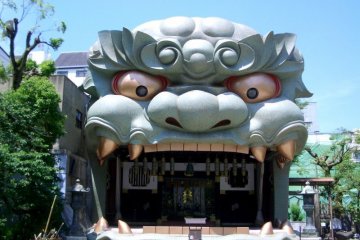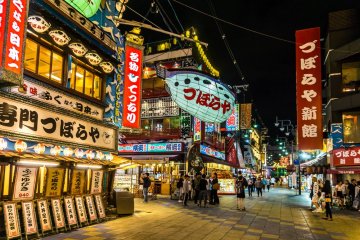
Super Nintendo World
Super Nintendo World opened in spring 2021 inside of Universal Studios Japan. This is another of the special are...

Universal Studios Japan (USJ) in Osaka is the most famous theme park in the Kansai region and one of four Universal Studios theme parks worldwide. It was the first Universal Studios-branded theme park to be built in Asia. Opened in March 2001, it is, after Tokyo Disney Resort, the most visited amusement park in Japan.
Universal Studios Japan has ten zones: Hollywood, New York City, San Francisco, Minion Park, Jurassic Park, WaterWorld, Amity Village, Universal Wonderland, The Wizarding World of Harry Potter and—new in 2021—Super Nintendo World. There is plenty for visitors to experience: from kid-friendly carousels to thrilling roller coasters and simulations based on popular films like Spiderman, Back to the Future, Terminator 2, and Jurassic Park.
In addition, you have many opportunities to take photos with the mascots of popular characters such as Snoopy, Hello Kitty and the Muppets. There are also daily shows and parades that make a big impression, especially at night with beautiful lighting.

Super Nintendo World opened in spring 2021 inside of Universal Studios Japan. This is another of the special are...

The Kaiyukan in Osaka is the largest aquarium in Japan and at the same time one of the largest in the world. It is located in the Minato district near the port area of Osaka. Opened in 1990, it is one of the largest indoor aquariums with a total water volume of more than 11,000 tons is home to around 620 animal and plant species. The main theme of the aquarium is the "Ring of Life" or the "Ring of Fire" and is represented by the arrangement of the more than 15 different pools. Each of the pools represents a specific region on the Pacific Ring of Fire and visitors can experience themed worlds on a tour from the Japanese forests to the Antarctic to the heart of the aquarium, the Pacific Ocean. In the latter, for example, there is a whale shark, the largest fish on earth. In addition to these permanent exhibitions, the Kaiyukan also offers some interactive highlights, where you can get close to different animal species and sometimes stroke and even feed them. The aquarium has a souvenir shop and is located directly at Tempozan Harbor Village, a shopping and entertainment complex with many restaurants and shops.

Namba Yasaka Shrine is a unique and standout destination among Osaka’s sacred spots. Located in the Namba District, Namba Yasaka is famous for its impressive lion head-shaped building called Ema-Den, which measures 12-meters high by 11-meters wide! Ema-Den and the surrounding temple structures are all post-war reconstructions of the original buildings that were destroyed in air raids and fires in 1945. Once you enter the relatively small shrine complex, you will come face-to-face with the fierce Ema-Den. The lion’s eyes, slightly tilted down, seem to stare right at you and its wide mouth reveals pointed teeth. Although the Ema-Den’s appearance is intimidating, its open jaw is meant to swallow evil spirits and leave you with good fortune. Ema-Den becomes even more menacing when the sun goes down and its eyes glow against the night. Why not visit this enormous lion head and let it gobble up your worries? Aside from the lion head, Namba Yasaka Shrine is also a pleasant springtime spot thanks to its numerous cherry blossoms. On the third Sunday of January, Namba Yasaka Shrine becomes home to the Tug-of-War ritual, which is an intangible folk cultural property of Osaka City. The Shinto event is a celebration of the Japanese myth of Susanoo-no-Mikoto who killed the serpent god Yamata-no-orochi and freed people from hardship.

Dotonbori, located along the canal of the same name, is a street in the Namba district of Osaka’s Chuo ward that epitomizes the city’s nightlife. The colorful area is an explosion of neon lights, mouth watering street food, retro vibes, clubs, stores, and bars. A popular saying associated with the street is kuidaore, which roughly means to go bankrupt after spending an enormous amount of money on food. To experience the essence kuidaore (responsibly, of course) be sure to check out this renowned partying spot and lose yourself in the contagious energy! Roots in the 1600s The historic street started in the 1620s as a theater district with kabuki and bunraku (puppet) establishments along the canal. Over the years, many theaters closed as people lost interest in the traditional arts, and unfortunately, most of the remaining theaters were destroyed in bombing raids during WWII. Today, Shochiku-za Theater stands as the only reminder of the street’s theater roots. Today Today, Dotonbori is one of Osaka’s top tourist destinations. When the sun goes down, flashy neon advertisements light up along the canal and streets. The rainbow of colors illuminates the night air, creating an exciting atmosphere that matches Dotonbori’s offerings. Walk along the bustling street and lose yourself in the tantalizing food smells, energetic chatter, and hypnotizing sights. Embrace Kuidaore Food Culture With a phrase like kuidaore associated with the street, there is no doubt that Dotonbori takes its food culture seriously. The street is one of the best places to experience Osaka cuisine, and the area’s flamboyant restaurants themselves are a feast for the eyes. You will need multiple nights to enjoy all of the street’s wonders! For a personalized and unforgettable experience, book a food tour with a local who can guide you through the best spots. Discover Dotonbori's top restaurants. See the Sights! After, while, or before you eat, explore the vibrant area. Seemingly every spot of the street is filled with dazzling lights, historic vibes, and unique charm. Listed below are some of Dotonbori’s staple destinations. Though be sure to explore off of the beaten path and discover the street’s many wonders yourself!